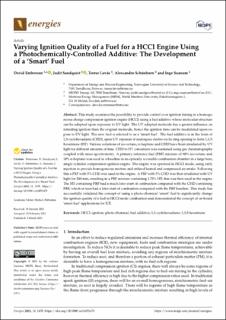| dc.contributor.author | Emberson, David | |
| dc.contributor.author | Sandquist, Judit | |
| dc.contributor.author | Løvås, Terese | |
| dc.contributor.author | Schönborn, Alessandro | |
| dc.contributor.author | Saanum, Inge | |
| dc.date.accessioned | 2021-05-10T08:59:54Z | |
| dc.date.available | 2021-05-10T08:59:54Z | |
| dc.date.created | 2021-05-07T14:36:54Z | |
| dc.date.issued | 2021 | |
| dc.identifier.issn | 1996-1073 | |
| dc.identifier.uri | https://hdl.handle.net/11250/2754560 | |
| dc.description.abstract | This study examines the possibility to provide control over ignition timing in a homogeneous charge compression ignition engine (HCCI) using a fuel additive whose molecular structure can be adapted upon exposure to UV light. The UV adapted molecule has a greater influence on retarding ignition than the original molecule, hence the ignition time can be modulated upon expose to UV light. The new fuel is referred to as a ‘smart fuel’. The fuel additive is in the form of 1,3-cyclohexadiene (CHD), upon UV exposure it undergoes electro-cyclic ring opening to form 1,3,5-hexatriene (HT). Various solutions of iso-octane, n-heptane and CHD have been irradiated by UV light for different amounts of time. CHD to HT conversion was examined using gas chromatography coupled with mass spectrometry. A primary reference fuel (PRF) mixture of 90% iso-octane and 10% n-heptane was used as a baseline in an optically accessible combustion chamber in a large bore, single cylinder compression ignition engine. The engine was operated in HCCI mode, using early injection to provide homogeneous mixture and utilized heated and compressed air intake. Following this a PRF with 5% CHD was used in the engine. A PRF with 5% CHD was then irradiated with UV light for 240 min, resulting in a PRF mixture containing 1.72% HT, this was then used in the engine. The HT containing PRF had a much later start of combustion compared with the CHD containing PRF, which in turn had a later start of combustion compared with the PRF baseline. This study has successfully validated the concept of using a photo-chemical ‘smart’ fuel to significantly change the ignition quality of a fuel in HCCI mode combustion and demonstrated the concept of on-board ‘smart fuel’ applications for ICE. | en_US |
| dc.language.iso | eng | en_US |
| dc.publisher | MDPI | en_US |
| dc.rights | Navngivelse 4.0 Internasjonal | * |
| dc.rights.uri | http://creativecommons.org/licenses/by/4.0/deed.no | * |
| dc.title | Varying Ignition Quality of a Fuel for a HCCI Engine Using a Photochemically-Controlled Additive: The Development of a ‘Smart’ Fuel | en_US |
| dc.type | Peer reviewed | en_US |
| dc.type | Journal article | en_US |
| dc.description.version | publishedVersion | en_US |
| dc.source.volume | 14 | en_US |
| dc.source.journal | Energies | en_US |
| dc.source.issue | 5 | en_US |
| dc.identifier.doi | 10.3390/en14051470 | |
| dc.identifier.cristin | 1908805 | |
| dc.relation.project | Norges forskningsråd: 255144 | en_US |
| dc.description.localcode | Copyright: © 2021 by the authors. Licensee MDPI, Basel, Switzerland. This article is an open access article distributed under the terms and conditions of the Creative Commons Attribution (CC BY) license (https:// creativecommons.org/licenses/by/ 4.0/). | en_US |
| cristin.ispublished | true | |
| cristin.fulltext | original | |
| cristin.qualitycode | 1 | |

